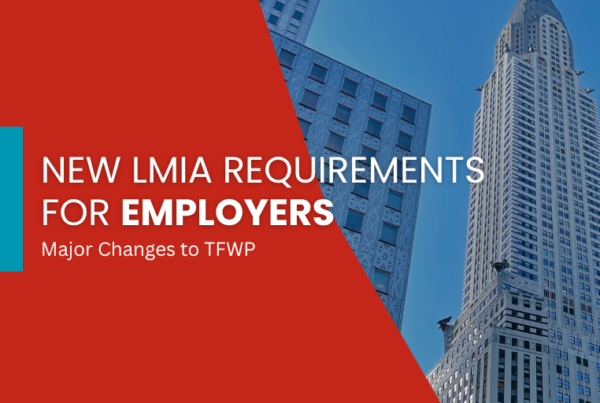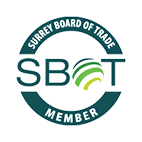If you’re an employer relying on the Temporary Foreign Worker Program, I understand the uncertainty you’re facing right now. There are stricter LMIA requirements, multi-million-dollar fines, decade-long bans, and surprise inspections. Canada is sending a clear message: non-compliance will not be tolerated.
As an RCIC, I tell every employer I consult with the same thing: these reforms weren’t designed to make hiring harder. They’re designed to reward businesses that prioritize Canadian workers while creating pathways for employers who genuinely need foreign talent.
If the TFWP has been your primary hiring strategy, these changes signal it’s time to evaluate more sustainable alternatives. The program is transitioning from a staffing solution to a strategic tool for specific, documented labour needs.
In this article, I’ll walk you through the new LMIA compliance requirements for employers, how to navigate sector-specific bans, what triggers inspections, and most importantly, how to build a workforce strategy that keeps you compliant and competitive.
Key Updates on Non-Compliance and Penalties
Employers of temporary workers are subject to inspections to ensure compliance with their responsibilities under the Temporary Foreign Worker Program or International Mobility Program. Non-compliant employers may face the following consequences:
- Administrative Monetary Penalty
- Ban from hiring temporary foreign workers (for a limited period of time)
For example: One employer in the fish and seafood sector received Canada’s largest penalty ever: $1 million and a 10-year ban.
Here are the latest updates on Employer Non-Compliance and Penalties from 2024-2025:
- ESDC conducted 1,435 employer compliance inspections
- Penalties doubled from $2.1 M to $4.9 M
- 36 employers banned (3 times than previous year)
- 30% of inspections were unannounced visits
- ESDC using AI to match payroll, LMIA terms, and work permits in real time
- Starting September 2025, employers must use Job Bank’s “Direct Apply“
- No fee refunds after non-compliance findings
Employer Compliance and Financial Protection
One thing that most employers don’t realize is that these reforms can actually safeguard your business in the long run. When you treat compliance as a living system rather than a paperwork exercise:
- You’re building protection worth millions.
- You’re avoiding penalties that could shut down your ability to hire foreign talent for years.
- More importantly, you’re reducing your over-dependency on a program that’s becoming harder to access.
LMIA Employer Compliance Gaps That Cost Millions
I work with employers every week who genuinely believe they’re compliant. They’ve done the advertising, submitted the forms and received LMIA approval. Then an inspection happens.
And that’s when I see the stress set in. Because the most common gaps aren’t dramatic violations. They’re operational oversights that busy employers consider minor but inspectors consider serious.
Let’s discuss what are these gaps:
- Wage discrepancies: Not paying wages exactly as stated in your approved LMIA. Even a $1 per hour difference can trigger a violation under the new review systems.
- Job description mismatches: Workers performing tasks outside their approved role. A farmer helping with roofing. A carpenter taking on supervision duties. Normal operations, but legally problematic.
- Missing documentation: Failing to maintain complete records from your LMIA application and recruitment process. ESDC can review your compliance for up to six years.
- Work permit oversights: Not tracking employee work permit expiry dates. Some employers continue employing workers whose permits expired months earlier, completely unaware they’re violating immigration law.
- Location transfers: Moving workers to different locations without updating the LMIA. One employer moved a worker to a branch office in another province. That single decision triggered a compliance finding.
These aren’t bad employers. They’re busy ones who don’t realize that immigration compliance requires the same attention as payroll or workplace safety.
New LMIA Inspection Process and its Impact
In the past, most inspections happened on paper. Employers received advance notice. They had time to prepare documentation. That gave everyone a sense of control. That’s changing. Now, 30% of inspections are unannounced. ESDC officers show up at your workplace without warning. They want to see real-time conditions, not prepared files.
They’re cross-referencing payroll data against LMIA submissions in real time. They’re comparing job titles on project permits with work permit conditions. They’re using AI-driven audits to identify discrepancies you didn’t even know existed.
In fiscal year 2024-2025, ESDC conducted 1,435 employer compliance inspections. 10% of employers were found non-compliant. it means one in ten companies misusing the program.
The government isn’t just making threats, they’re taking action. Here are some recent examples:
- Bolero Shellfish Processing (New Brunswick): $1 million fine and 10-year ban for failing to provide proper wages, working conditions, and a workplace free of abuse.
- Canadian Tire Store (Toronto area): $111,000 fine for paying workers less than promised and misrepresenting job duties.
- Agriculture employer: $212,000 fine and 2-year ban for poor working conditions and missing documentation.
- Construction company: $161,000 fine and 5-year ban for wage violations and poor working conditions.
These penalties show the government is serious about protecting your rights as a temporary foreign worker.
How to Prepare for New LMIA Requirements as an Employer?
1. Conduct an honest internal audit
Pull every LMIA from the past three years and compare what you declared against what’s actually happening. Job titles, wages, work locations. If there are discrepancies, document them now. ESDC’s new protocol rewards self-auditing and proactive correction.
2. Assign someone to own compliance
This doesn’t have to be a lawyer. Your HR manager or site administrator can manage the LMIA file from application to closure. The key is having one person responsible for tracking changes and maintaining records.
3. Digitize everything
ESDC increasingly requests digital files during audits. Scan LMIA approvals, employment contracts, pay stubs, and T4s into organized folders. Make sure your payroll system and HR records actually talk to each other.
4. Build change-tracking into your operations.
Any shift in a worker’s tasks, location, wage, or supervisor should trigger an internal notification. Train your site supervisors that operational changes have immigration implications.
The goal isn’t perfection. It’s building a system where compliance becomes part of how you operate, not something you scramble to prove during an inspection.
LMIA Record-Keeping for Changing Roles
In dynamic sectors like construction, agriculture, hospitality, and food processing, where job responsibilities frequently change, it’s crucial that every alteration in employee duties is accurately documented in your LMIA compliance records. For instance:
- In construction, if a framer pauses framing duties to help with roofing, your payroll and job‐site logs must show that the worker’s role temporarily shifted and that their wage rate and job title remain consistent with the approved LMIA.
- In hospitality, when a line cook covers prep work, you must document that the cook performed those duties under the same wage and conditions authorized by the LMIA decision letter.
- In agriculture, seasonal workers often rotate between harvesting fields and packing produce in a shed. Each task change needs corresponding entries in your shift schedules, time-sheets, and payroll records to confirm that “packing” or “harvesting” duties align with the tasks and wages specified in the LMIA application.
The Alternative Pathway Most Employers Miss
Most employers only know one way to hire foreign workers: the LMIA process through the Temporary Foreign Worker Program. But there are alternative pathways that bypass the LMIA entirely. These include:
1. Treaty Work Permits
- Treaty work permits under international trade agreements like CUSMA, CETA, and CPTPP allow you to hire workers from treaty partner countries without going through the LMIA process.
- No extensive advertising requirements and labour market impact assessment.
- No 20% wage premium above median wages that high-wage LMIAs now require.
- Not every role qualifies, only for certain professionals, occupations, and business investors.
2. Intra-Company Transfers
The ICT program allows multinational companies to transfer key employees to their Canadian operations without LMIA requirements.
3. C10 and C11 Categories
These categories serve entrepreneurs, self-employed individuals, and professionals bringing significant benefits to Canada.
- C10 – Significant Benefit to Canada
- C11 – Entrepreneurs and Self-Employed
4. Francophone Mobility
This program specifically targets French-speaking workers to support Canada’s bilingual mandate and strengthen Francophone communities outside Quebec.
The key is matching the right pathway to your business reality. What sector are you in? What kind of workers do you need? Where are your candidates coming from?
When an employer comes to me saying “we need workers but LMIA isn’t working,” I assess eligibility across multiple programs. It includes Treaty permits, Intra-company transfers, Global Talent Stream, International Mobility Program exemptions and other options.
Ready to Protect your Business and Hire Confidently?
Contact our licensed experts for professional advice.
Why Employers Need Immigration-Integrated Workforce Planning?
The bigger story here isn’t just about compliance tightening. Canada is quietly pushing employers from dependency to durability.
For years, the TFWP was a lifeline for construction, hospitality, and agriculture. It filled immediate labour gaps. But it also created a cycle of constant recruitment, permit renewals, and worker turnover. That model is breaking down by design.
If your workforce strategy starts and ends with LMIAs, you’re not hiring. You’re firefighting. The real pivot is moving from transactional hiring to immigration-integrated workforce planning. Building a pipeline of workers who can transition to Permanent Residents and become long-term employees.
Use the TFWP as a bridge, not a business model
Bring in foreign workers when there’s an urgent shortage. But from day one, map their potential permanent pathways.
- A foreign carpenter on an LMIA work permit could later qualify for BC PNP’s Skilled Worker stream or Express Entry if you support their transition.
- A food service supervisor under an LMIA can build eligibility for Provincial Nominee Programs or Canadian Experience Class.
Hire with the end in mind. Every TFWP hire should have a possible PR track. Retention begins the day a worker arrives.
When you integrate immigration strategy into HR, you’re not just outsourcing applications. You’re mapping which roles qualify for PR programs. You’re tracking employees’ progression toward eligibility through language tests, work hours, and education equivalence.
You’re designing internal sponsorship programs where you commit to supporting permanent residence for select staff.
That one gesture transforms loyalty, productivity, and retention. Workers invest more when they know their employer believes in their future here.
The next wave of talent is choosing employers based on immigration outcomes.
When your company becomes known as a PR-friendly employer, your job postings stand out. Both to foreign talent and to Canadian newcomers already here.
I’ve seen clients cut recruitment costs by 40% once they built a reputation for long-term sponsorship rather than short-term contracts.
New LMIA Requirements Require New Mindset
Stop thinking like a recruiter. Start thinking like a nation builder.
The businesses that will thrive aren’t scrambling to fill positions. They’re building systems that make compliance, fairness, and long-term retention part of their culture.
Treat every LMIA, every hire, and every audit as a chance to strengthen your foundation
The biggest mistake isn’t noncompliance. It’s complacency. Employers across all sectors must start treating every LMIA not just as a gateway to hiring, but as a living compliance document. Any change in role, pay, or work site must be documented and, when necessary, amended or reported. This applies whether you’re in construction, hospitality, agriculture, or any other industry relying on the TFWP.
Important note: The Canadian government has proposed to introduce a new permanent economic class under the IRPA for TEER 4 and 5 workers. This is not fully in force yet in all respects.
Take Professional Help from Licensed Consultants
Canada’s immigration system is prioritizing pathways to permanent residency. Employers who adapt now will have stable, experienced, and grateful teams by 2027. The ones who don’t will still be posting the same job ads every year, fighting the same labor shortage again and again.
The employers who will thrive under the 2025-2026 reforms aren’t those who hire faster. They’re those who document better.
At Elaar Immigration, our licensed RCICs specialize in corporate immigration strategy and compliance. We help Canadian businesses conduct compliance audits, identify risks before inspections, and evaluate eligibility for LMIA-exempt streams.
Ready to protect your business and hire confidently?
Disclaimer: This article is for general information only and is not legal advice. Immigration policies change frequently; always verify with official IRCC or Global Affairs Canada sources, or consult a licensed RCIC.










